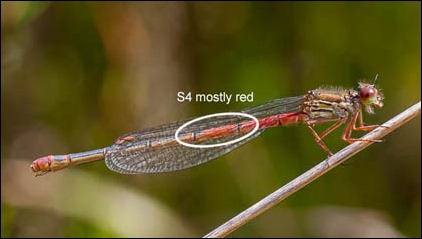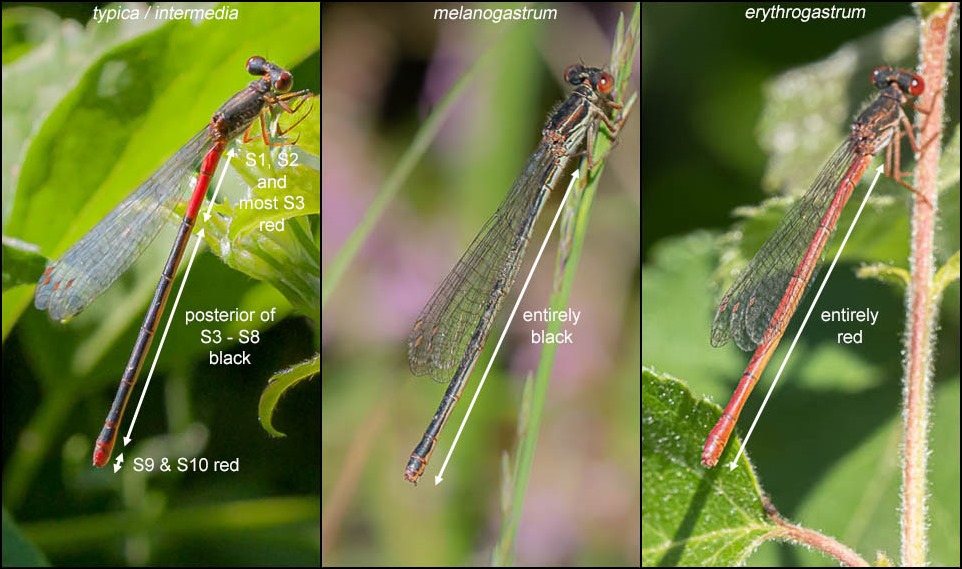[This is something of a partner article to Large Red Females in that both Large Red Damselfly (Pyrrhosoma nymphula) and Small Red Damselfly (Ceriagrion tenellum) females are polymorphic, i.e. they come in multiple colour forms, and in the naming of the colour forms of both species some confusion exists in our publications.]
The UK’s two most favoured field guides [at the time of writing, 2022] are Field Guide to the Dragonflies and Damselflies of Great Britain and Ireland by Brooks/Cham/Lewington, which is an illustrative guide, and Britain’s Dragonflies by Smallshire/Swash, which is a photographic guide. Some people prefer illustrations whilst others prefer photographs. Personally, I think they make excellent complementary companion volumes.
Both volumes show examples of three colour forms which, I think, matches most people’s current expectations. They do not agree on terminology, however.
Smallshire/Swash specifically states three colour forms and names them:
- typica (the “normal” form);
- melanogastrum (a dark abdomen occurring “quite frequently”);
- erythrogastrum (an “uncommon” red form, like the male – androchrome).
However, Brooks/Cham/Lewington doesn’t specifically state a number of female forms but illustrates and describes three:
- erythrogastrum (entirely red);
- melanogastrum (entirely bronze-black);
- intermedia (black but marked red “on the basal segments”).
The illustration of intermedia in Brooks/Cham/Lewington matches that of typica in Smallshire/Swash. Thus, intermedia and typica in these two volumes appear to be one and the same thing – synonyms of each other.
 So what is this then? It’s not all black [melanotum]; it’s not all red [erythrogastrum]. This looks like typica, or, at least it did to me until I realized that the central black area did not extend over the whole of S4. Concentrating on taking a photograph rather than detail, I frequently suffer from “viewfinder blindness”. In this specimen, S4 is mainly red.
So what is this then? It’s not all black [melanotum]; it’s not all red [erythrogastrum]. This looks like typica, or, at least it did to me until I realized that the central black area did not extend over the whole of S4. Concentrating on taking a photograph rather than detail, I frequently suffer from “viewfinder blindness”. In this specimen, S4 is mainly red.
Returning to 1988 when R. R. (Dick) Askew published the first European Field Guide, The Dragonflies of Europe, we see a slightly different picture. His volume is quite detailed and specific in its description:
Females of C. tenellum are polymorphic, four colour forms being recognizable:
- typica
- S1-3 are dorsally red except for a black spot at the base of S1 and black apex to S3, S4-8 are dorsally mainly black and S9, 10 are mainly reddish
- erythrogastrum
- The homeochrome form, in which the abdomen is as red as in the male.
- intermedium
- The abdomen is dorsally red but S6-8 sometimes also S3-5 are apically black.
- melanogastrum
- The dorsal surface of the abdomen, except to intersegmental incisures, is almost entirely bronzed black…
Here, typica and intermedium/intermedia are distinct and clearly not synonyms of each other. His descriptions of typica, erythrogastrum and melanogastrum do match the three illustrations offered by Smallshire/Swash and Brooks/Cham/Lewington, it’s just that Brooks/Cham/Lewington uses the term intermedia instead of typica.
Those who tend to use FIeld Guide to the Dragonflies of Britain and Europe by K-D Dijkstra/Lewington may not be surprised. Descriptions in editions of this volume (2006 & 2020) match those of Askew:
Four colour forms of female are recognized … the forms differ by the extent of black on the abdomen and face:
- typica
- abdomen black with most of S1-3 and S9-10 red, extent of black my vary slightly
- erythrogastrum
- abdomen and face all red as in the male
- melanogastrum
- entire upper side of abdomen and most of face black
- intermedium
- includes all largely red but black-marked varieties between the first two forms.
For some reason, the 2020 edition of Dijkstra/Lewington modifies three of the names, presumably for language gender matching reasons, to melanogastra, erythrogastra, and intermedia.
So, in both Askew and Dijkstra, intermedium/intermedia is a fitting description of my specimen above that doesn’t fit any of those limiting their descriptions to three forms.
If this classification dates from 1988 [actually it dates from Sélys in the 19th century], what happened to the fourth form in our two most frequently used volumes? My suspicion regarding the Brooks/Cham/Lewington publication is that they smashed together intermedia and typica – the latter could be regarded as a specific format of intermedia – intermedia thus becoming everything between the all-black melanogastrum and the all-red erythrogastrum.
I’m going with the four colour form classifications in Askew and Dijkstra.


Leave a Reply